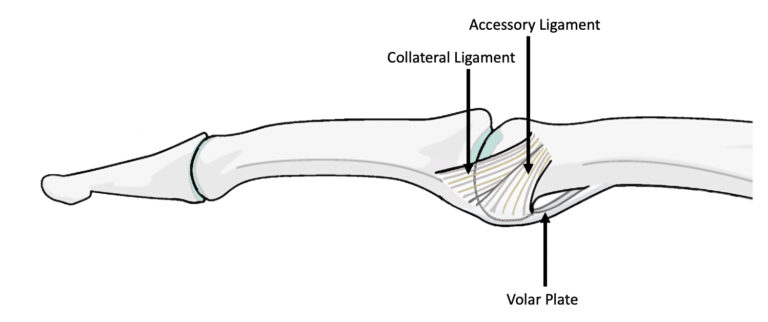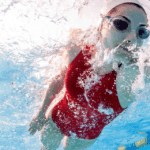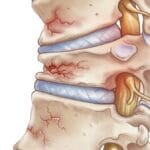Volar Plate Injury: Mechanism and Causes
A volar plate injury occurs when excessive hyperextension forces the finger joint beyond its normal range of motion, leading to a tear or detachment of the volar plate, a ligamentous and cartilaginous structure located on the palmar aspect of the joint. This injury predominantly affects the proximal interphalangeal (PIP) joint of the index, middle, ring, or little fingers.
Etiology and Mechanism of Injury
Volar plate injuries are frequently observed in sport-related trauma and are often caused by a direct impact to the fingertip, such as when a ball strikes the end of the finger in sports like football or netball. Additionally, falling onto an outstretched hand or inadvertently catching a finger during daily activities may lead to excessive stress on the volar plate, resulting in ligamentous strain, partial tearing, or avulsion fractures where a small fragment of bone is displaced due to the forceful pull of the ligament.
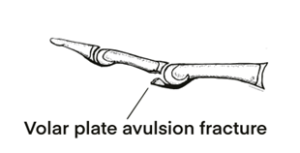
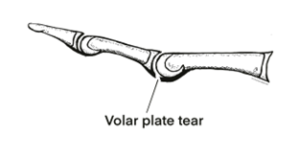
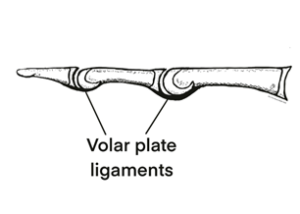
Clinical Presentation and Diagnosis of Volar Plate Injury
Symptoms
A volar plate injury typically presents with the following clinical signs:
- Pain and tenderness localized around the affected joint
- Swelling at the site of injury, often extending to adjacent areas
- Joint stiffness, accompanied by difficulty in both flexion and extension of the injured finger
- In severe cases, the affected finger may appear crooked or deformed, indicating possible joint instability or misalignment
Diagnostic Approach
The diagnosis of a volar plate injury is established through a combination of clinical history, physical examination, and imaging studies.
- Clinical History – The mechanism of injury, particularly a hyperextension force applied to the finger, provides critical diagnostic clues.
- Physical Examination – The healthcare provider assesses for swelling, tenderness, and deformity at the affected joint. A stress test is often performed to evaluate joint stability and the integrity of the volar plate.
- Radiographic Imaging – An X-ray is obtained to rule out associated fractures or joint dislocations, particularly at the site where the volar plate attaches to the bone.
Management of Volar Plate Injury
Treatment Objectives
The primary goal of treatment is to restore pain-free movement while ensuring joint stability and preventing long-term stiffness or deformity.
Non-Surgical Management
Most volar plate injuries are effectively managed without surgical intervention, relying on immobilization, pain control, and rehabilitation exercises.
- Immobilization – To protect the injured finger during healing, one of the following methods is used:
- Buddy Strapping (Neighbour Strapping) – The injured finger is strapped to an adjacent finger to provide support and limit excessive movement.
- Splinting – In some cases, a splint may be applied to the dorsal (back) side of the finger to provide additional protection.
- Pain and Swelling Management –
- Simple analgesics such as paracetamol or nonsteroidal anti-inflammatory drugs (NSAIDs) help alleviate pain.
- Cold therapy (icing) can reduce swelling when applied intermittently.
- Hand elevation above heart level minimizes edema and discomfort.
Duration of Immobilization:
The finger is typically strapped or splinted for approximately three weeks, after which a structured rehabilitation program is initiated to restore range of motion and prevent stiffness.
Would you like me to include information on complications or rehabilitation strategies?
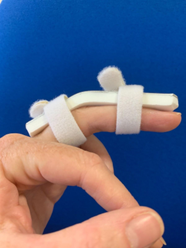

During the early stage it is important to move your finger regularly to reduce swelling and increase your movement. This means carefully following finger exercises given by your healthcare team. A hand therapist or physiotherapist may continue the treatment of your injury.
The exercises below can start immediately. The exercises should be done within a comfortable range. They should get easier over time.
Buddy strapping based exercise
Exercise 1
Bend your top two knuckles into a hook position with the big knuckles straight. Return your fingers to an open position. Repeat 10 times 4 to 6 times/day.
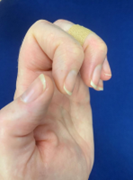
Exercise 2
Bend your fingers to the palm to make a full fist. Straighten your fingers back to the splint. Repeat 10 times 4 to 6 times/day
All movements should be done within comfort
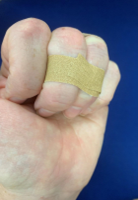
Splint based exercises
Exercise 1
Loosen the top Velcro strap but retain the bottom strap around the base of your finger.
Bend your fingertips towards your palm to try and make a hook. Straighten your fingers back to the splint. Repeat 10 times 4 to 6 times/day.
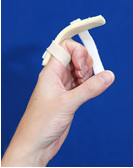
Exercise 2
Retain the bottom strap around the base of your finger as above
Bend the fingers to the palm to make a full fist. Straighten your fingers back to the splint. Repeat 10 times 4 to 6 times/day
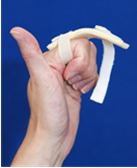
Recovery from a volar plate injury
These injuries usually heal well and your finger returns to good use. Your healthcare team will give specific advice. You may:
- Return to light everyday activities with your strapping or splint on, avoiding heavy activities that cause pain.
- Return to work with the strapping or splint on if your type of job allows.
- Avoid sporting activities while your finger heals.
- Return to driving when you feel safe to control the vehicle. As the driver, you are responsible to drive safely.
However:
- Your injured finger can take longer than expected to heal. This means the swelling and some mild pain may be present for one to two years after the strapping or splint is stopped.
- Your finger is sometimes sensitive to touch or cold for one or two years.
- Less often stiffness in your finger joint can become a long term problem. Early movement helps to prevent this. If your finger movement is becoming worse six weeks after the injury, please contact your healthcare provider.
FAQs
1. What should I do if my neighbour strapping comes off?
You can reapply strapping yourself. You should place the strapping across the flat parts of your fingers, allowing movement at the joints.
2. How do I treat the swelling and pain in my finger?
Use simple painkillers regularly. Use ice and keep your finger moving. Keep your hand at the level of your heart to reduce swelling.
3. What should I do if my finger is becoming more stiff months after the injury?
The exercises for your finger are very important, so continue these. If the stiffness is worsening, seek advice from your healthcare provider.
4. What do I do if my finger joint is still swollen after three months?
Swelling of your finger joint after a volar plate injury is normal. It often continues for one or two years.
5. How often should I do my finger exercises each day?
You can complete the exercises four to six times each day. The movements should be done within comfort.

